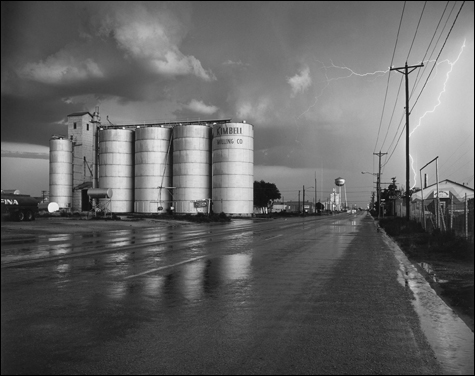Frank Gohlke at the Addison, ‘Pulp Function’ at the Worcester Center for Crafts, and ‘Expanded Sculpture 2’ at 119 Gallery
By RANDI HOPKINS | April 2, 2008

Frank Gohlke, Grain Elevator and Lightning Flash, Lamesa, Texas (1975) |
“Accommodating Nature: The Photographs of Frank Gohlke” at Addison Gallery of American Art, Phillips Academy, 180 Main St, Andover | April 12–July 13 | 978.749.4015
“Pulp Function” at Worcester Center for Crafts, 25 Sagamore Road, Worcester | April 17–May 26 | 508.753.8183
“Expanded Sculpture 2” at Gallery, 119 Chelmsford St, Lowell | April 8–May 3 | 978.452.8138 |
In the 1994 documentary Crumb, underground cartoonist Robert Crumb reveals that he used to ask friends to drive him around town so that he could snap photographs of power lines and telephone poles. He would later refer to these images to give his drawings an extra, almost subliminal grounding in reality. It was in this same spirit of vérité presentation — without editing out the ostensibly unattractive or marginal — that photographer Frank Gohlke turned his camera on the American landscape in the early 1970s, making a clear break with the tradition that prizes landscape photographs depicting astonishing natural beauty untainted by man’s hand. Gohlke’s early photographic explorations of his Wichita Falls (Texas) childhood, his images of destruction and rebuilding after a tornado struck that town in 1979, and his long-term project photographing the effects of the eruption of Mount St. Helens in 1980 are all on view in “ACCOMMODATING NATURE: THE PHOTOGRAPHS OF FRANK GOHLKE,” which opens at the Addison Gallery of American Art on April 12. Gohlke looks at nature not as something that we gaze on from a distance but as the often defiant or disappointing environment where we live: grain elevators dotting the vast expanses of the Midwest; the Sudbury River in Massachusetts in the late 1980s, overgrown and threatened by pollution.Paper, which so often serves as the humble underpinning of an artwork, steps into the spotlight in “PULP FUNCTION,” which opens at the Worcester Center for Crafts on April 17. Organized by the Fuller Craft Museum in Brockton and curated by Lloyd E. Herman, founding director of the Smithsonian’s Renwick Gallery, the show presents more than 80 objects exploring creativity in paper, in media as diverse as jewelry, clothing, furniture, books, and sculpture. Works include Sylvia Seventy’s cast-paper vessels, Mia Hall’s tissue-and-paper-towel wedding dress, Long-Bin Chen’s Buddha head made from Chinese phone books, and Leslie Miller’s intricate work with cut paper.
Opening at 119 Gallery on April 8, the group show “EXPANDED SCULPTURE 2” offers three-dimensional work by five artists using video projection, animation, and three-dimensional prints in addition to such traditional sculptural materials as wood and metal. The new work that Andy Zimmermann, Alicia Renadette, Vivian Pratt, Donna Dodson, and Bebe Beard will present includes Zimmerman’s Black Flutter, which is made up of 396 welded metal lily pads that form an undulating surface onto which video is projected.
On the Web
www.andover.edu/addison
www.worcestercraftcenter.org
www.119gallery.org
 Related
Related:
Naughty by nature, Road trips, Summer daze, More 
- Naughty by nature
Landscape has inspired artists as varied as the romantic 19th-century Hudson River School painters and the macho 20th-century Earth Artists.
- Road trips
In the fall of 1883, Isabella Stewart Gardner — more than a decade before she would develop her museum on Boston’s Fenway — traveled to China.
- Summer daze
One of the invigorating qualities of summer art shows in Boston is their relative playfulness. Slideshow: Images from the galleries
- Generation gap
It’s an uneven show with a dour vision that leaves a mediciny taste in your mouth — and, I think, offers signs of a generation gap among curators.
- Power rangers
Adam Ryder was fascinated, he said, by long-distance, high-tension power lines and their scruffy right-of-ways.
- Fever dreams
Written in the tradition of the historieta — pulp comics sold in the tens of millions monthly from every Mexican newsstand and bodega — Dead in Desemboque comes across like a dying gringo’s border desert mirage.
- The right profile
Contemporary African-American artists have taken on issues of race and American identity in a wealth of ways, from Kara Walker’s provocative silhouette narratives to Fred Wilson’s discomforting black "collectibles" to William Pope L’s agonizing acts of crawling.
- Drawing conclusions
“We face the audience more in American comics than characters do in Japanese and European comics,” says McCloud. “Here in America characters tend to block you at the door.”
- Rockets men
In 1982, two brothers from Oxnard, California, 60 miles northwest of LA, self-published the first issue of a comic they called Love and Rockets .
- Boston exposures
Photographer Nicholas Nixon of Brookline first burst onto the scene in the show "New Topographics."
- Alternative universe
In the 1930s and '40s, Boston painters developed a moody, mythic realism. They mixed social satire with depictions of street scenes, Biblical scenes, and mystical symbolic narratives, all of it darkened by the shadow of the Great Depression and World War II.
- Don’t leave me this way
Leaves lead a wild life, and each leaf’s physical structure reflects both its individual biography — revealing the pathways, for example, of insects that have eaten their way across a leaf’s surface.
- Less

 Topics
Topics:
Museum And Gallery
, American Art Phillips Academy, Frank Gohlke, Robert Crumb, More  , American Art Phillips Academy, Frank Gohlke, Robert Crumb, Bebe Beard, Fuller Craft Museum, Smithsonian Institution, Less
, American Art Phillips Academy, Frank Gohlke, Robert Crumb, Bebe Beard, Fuller Craft Museum, Smithsonian Institution, Less 